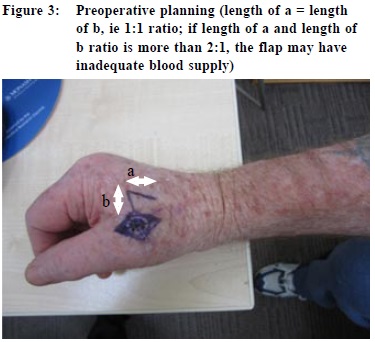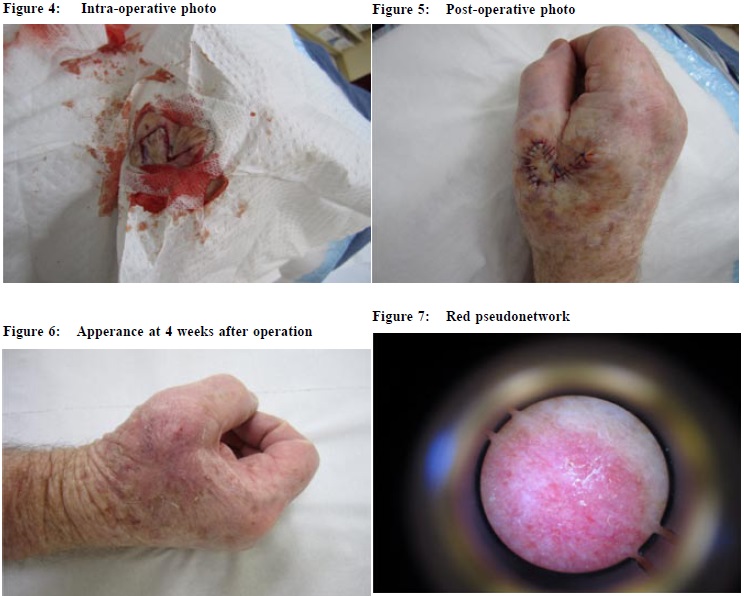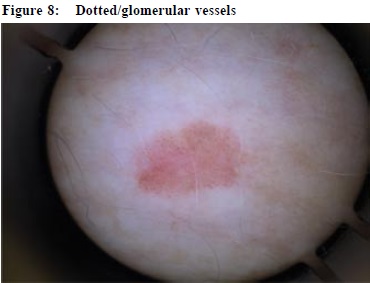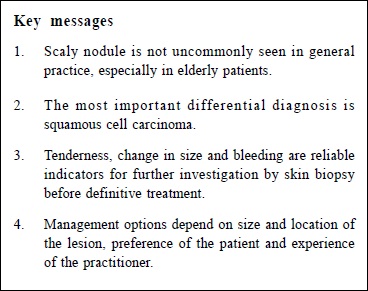
|
September 2013, Volume 35, No. 3
|
Update Articles
|
An elderly man with a painful scaly noduleWing-yiu Lai 黎永耀 HK Pract 2013;35:97-100 Summary Scaly nodule is a common presentation in general practice. A careful assessment by history and appropriate examination by dermoscopy is recommended to avoid missing skin cancer and associated medico-legal consequence. 摘要 鱗狀結節是基層醫生常見的情況,通過詢問詳細病史和適當皮膚鏡檢查,可以避免漏診皮膚癌以及相關的醫療法律糾紛。 Case history A 73 years old gentleman presented with a painful and scaly nodule over his right hand for several months. He had a previous history of skin cancer with multiple excisions done. On examination, a hyperkeratotic tender nodule was seen on his right hand (Figure 1).
Dermoscopy showed a non-pigmented raised lesion with no specific vessels seen due to the thick keratin (Figure 2).
The provisional diagnoses were squamous cell carcinoma (SCC), hypertrophic solar keratosis, seborrheic keratosis or wart . Incisional biopsy confirmed SCC. I discussed with patient options of complete excision and defect repair and he agreed for a rhomboid transposition flap to close the defect as direct closure was not ideal in this case (Figure 3).
After excision of the residual tumour with 5 mm margin, incision was made to prepare the rhomboid flap and after adequate undermining and haemostasis, I put several 4/0 Monosyn stitches to place the flap in the correct position without tension (Figure 4) and one continous 4/O superficial stitch to close the side of wound (Figure 5). Postoperatively, sutures were removed on day 14 and no complications were noted or reported. Histology report revealed clear margin of excision (Figure 6).
Discussion Australia is known to have the highest skin cancer incidence rate in the world.1 Approximately two in three Australians will be diagnosed with skin cancer (either melanoma or non-melanoma skin cancer (NMSC)) before the age of 70.2 Though melanoma is the least common type of skin cancer, it is the most life threatening. In 2007, there were 10,342 new cases of melanoma which was the fourth commonest form of cancer in Australia.4 Total deaths from melanoma were 1,279.3 NMSC is the commonest cancers diagnosed in Australia, with approximately 430,000 new cases in 2008.4 Of these, an estimated 296,000 were basal cell carcinoma (BCC), and an estimated 138,000 were squamous cell carcinoma (SCC). In 2007, there were 448 reported deaths from NMSC.3 In my experience, majority of my patients in skin cancer practice are Caucasian (>90%) and they were seen in Victoria in Australia. Although skin cancer (particularly melanoma) in Chinese patient is not as common as in Caucasian, the presentation in this case is not uncommon from my previous working experience in Hong Kong. Tenderness, change in size and bleeding are reliable indicators to differentiate SCC from solar keratosis.5 Due to the presence of tenderness and background history of skin cancer in this patient, biopsy is mandatory to exclude SCC Dermoscopy is a very effective tool for helping a clinician to get a provisional diagnosis and guide the decision for further intervention. In a recent progression model, a red pseudonetwork (Figure 7) was significantly associated with solar keratosis, whereas dotted/glomerular vessels (Figure 8), diffuse yellow opaque scales and microerosions were significantly more prevalent among SCC in-situ. Hairpin vessels, linear irregular vessels and targetoid hair follicles, white structureless areas, a central mass of keratin (Figure 2) and ulceration were significantly associated with invasive SCC,6 in this case, white structureless area with central mass of keratin was the feature seen and histology confirmed well differentiated SCC.
Preoperative planning is important for successful removal of skin cancer and closure of defect. Identification of relaxed skin tension lines, assessment of reservoir of skin laxity including mobility of skin surrounding the defect and donor sites are vital for consideration in flap design. Undermining of defect, placement of subdermal stitches to reduce wound tension and eversion of wound by superficial stitches is also very important in order to have a good cosmetic result. Direct closure after elliptical excision is always recommended but in this case, rhomboid transposition flap is used as the size or shape of the lesion does not permit easy direct closure using a standard fusiform excision due to tension around the joint area and this may affect smooth movement of fingers after operation. Rhomboid transposition flap is not the only option but is chosen because the orientation of relaxed skin tension line in this case allows the easiest closure of the defect by this method. Rhomboid transposition flaps have been used successfully in reconstruction of defects on the cheek, temple, lips, ears, nose, chin, eyelids, and neck. Rhomboid transposition flaps are full-thickness local flaps with a random blood supply and they rely upon the dermal-subdermal plexus of blood vessels. Pedicle width determines the amount of circulation within the dermal-subdermal plexus. On head and neck region, it is considered to be of minor importance due to vigorous blood supply but in this case, the safe maximum lengthto-width ratio of the pedicle will be 1:1 instead of 2-4:1 in the head and neck region. Adequate haemostasis by hyfrecator and avoidance of traumatising the dermis when undermining are also important to reduce the chances of partial or complete flap necrosis. Last but not least, heavy smokers or patients with diabetes mellitus have a higher complication rate with all flap procedures. Conclusion In elderly patients presenting with a scaly nodule, it is recommended to enquire about the personal or family history of skin cancer and symptoms of the nodule. Dermoscopy can help in differentiating the diagnosis and is an essential tool for skin cancer practice. This case aims to remind us to think about this important diagnosis (SCC) and not to presume that it is just a wart or seborrheic keratosis (especially without dermoscopy) before doing any definitive treatment.
Wing-yiu Lai, MBBS (HK), Dip. Derm (Glas), Dip. Ger Med RCP (Lond), FHKAM
(Family Medicine)
Skin Cancer Practitioner Correspondence to : Dr Lai Wing-yiu, Manor Lakes Medical Centre, Cnr Ballan Rd & Manor Lakes Blvd, Wyndham Vale VIC 3024, Australia
References
|
|





